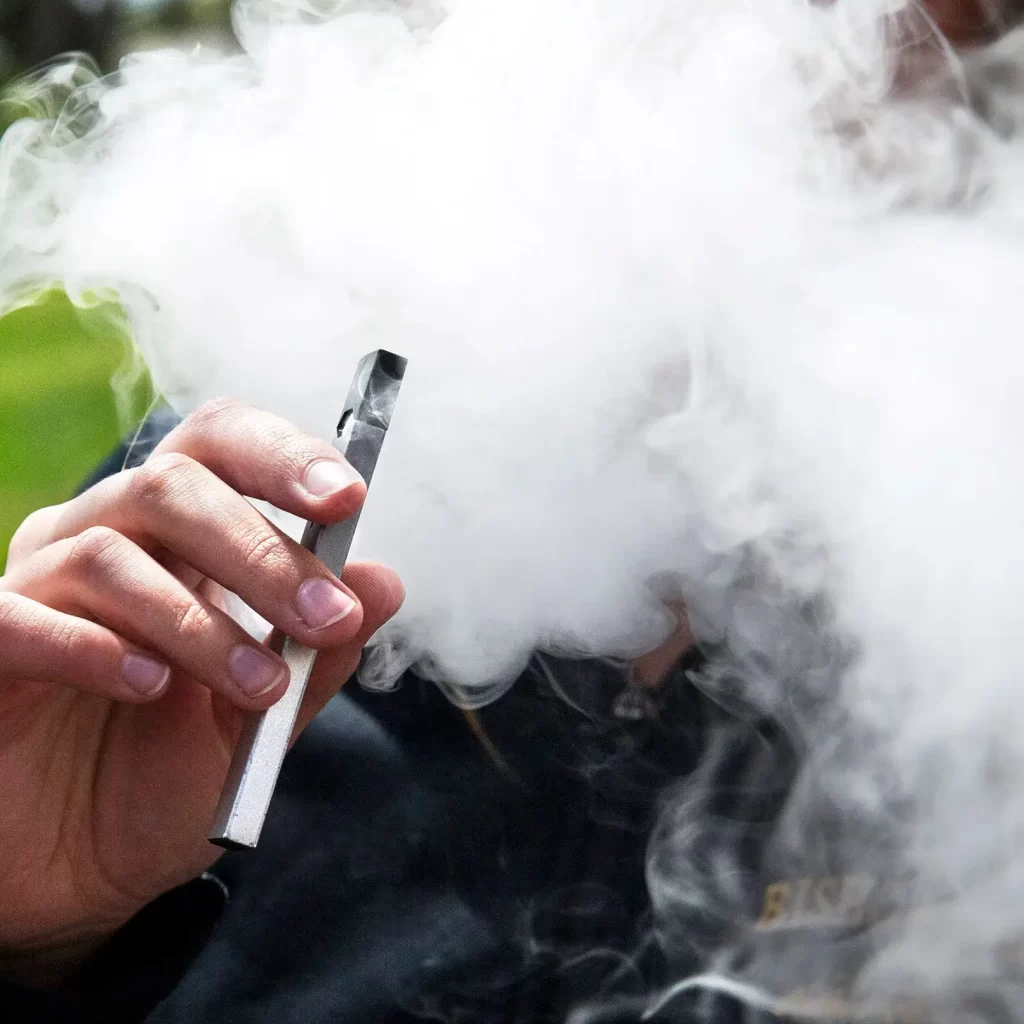WARNING: This product contains nicotine. Nicotine is an addictive chemical.
The question of how long vape clouds, the visible exhalation from e-cigarettes, persist in indoor spaces has been a topic of interest and concern. Recent scientific investigations shed light on this matter, revealing that vape clouds exhibit a remarkable characteristic – they dissipate within seconds, allowing air quality to promptly return to normal levels. This stands in stark contrast to the lingering nature of traditional cigarette smoke, which can take over 30 minutes to disperse and normalize indoor air quality.
E-cigarettes, commonly known as vapes, function by heating an e-liquid containing nicotine and other compounds to create an aerosol or vapor. This vapor is exhaled by users, forming visible clouds. However, the behavior of these clouds differs significantly from the long-lasting presence of smoke emitted by traditional cigarettes.

Scientific studies, including a notable 2018 study involving blu’s parent company Fontem Ventures, have empirically demonstrated that the vapor clouds generated by e-cigarettes rapidly break down within seconds after exhalation. This swift evaporation ensures that the indoor air quality swiftly returns to baseline levels, contributing to a more favorable environment for both vapers and non-vapers alike.
The implications of this finding are significant, as it dispels concerns about prolonged exposure to vape clouds within indoor spaces. With traditional cigarette smoke being notorious for its lingering presence and adverse effects on air quality, this scientific insight underscores the relative efficiency and reduced impact of vaping on indoor environments.

The debate surrounding the effects of vaping versus smoking continues to evolve, with a recent study shedding light on the impact of these practices on indoor air quality. Researchers have delved into the dynamics of particle concentrations emitted indoors after exhaling, uncovering some intriguing insights.
In a head-to-head comparison, e-cigarettes and traditional cigarettes were put to the test to determine their influence on the air we breathe. The results revealed a remarkable difference in how these two practices affect indoor environments.
Particles from conventional cigarette smoke are notorious for lingering in the air for an extended period, often taking 30 to 45 minutes to disperse. In contrast, the study found that particles emitted from e-vapor products evaporate within a matter of seconds, even in indoor settings.
The concept of secondhand vapor, often mistaken for secondhand smoke, warrants clarification. Secondhand vapor refers to the aerosol exhaled by e-cigarette users into the surrounding atmosphere. Contrary to popular belief, this vapor doesn’t linger in the air to the same extent as secondhand smoke. However, in confined spaces, there is a possibility of bystanders inhaling some of the exhaled aerosol.
Differentiating from secondhand smoke, secondhand e-cigarette vapor doesn’t contain the same components. Smoke arises from the combustion of materials like tobacco, generating volatile gases, carbon monoxide, and carcinogenic solid particles, often referred to as tar. While secondhand smoke exposure is a known hazard, e-cigarette vapor lacks many of these harmful elements.

1. Humidity: Humidity emerges as a key conductor orchestrating the lifespan of vape smoke. Elevated humidity levels bear the power to morph smoke droplets, inducing their growth and hastening their descent to the earth. This metamorphosis curtails the time for which the smoke remains suspended in the air, accentuating its fleeting nature.
2. Temperature: Temperature steps onto the stage as a pivotal protagonist shaping the destiny of vape smoke. Warmer temperatures lend wings to the smoke’s dispersal, compelling it to dissipate with swiftness. Conversely, colder temperatures coax the smoke to linger, elongating its presence in the atmospheric symphony.
3. Airflow: The ballet of vape smoke’s presence finds its choreography in the currents of airflow. The vigor and direction of air movement wield a profound impact on the smoke’s duration. A space infused with vigorous air currents, propelled by fans or open windows, orchestrates the rapid dispersion of the smoke, leaving behind transient traces.
Ventilation emerges as an architect of vape smoke’s fate, designing its longevity within enclosed spaces. Spaces fortified with effective ventilation mechanisms, be it through open windows or air conditioning, curtail the smoke’s tenacity. In contrast, areas bereft of proper ventilation nurture the enduring presence of vape clouds.
When vape clouds linger in a room, a quick solution to restore air quality is essential. Here’s a collection of effective strategies that can swiftly banish vape smoke, ensuring a fresh and comfortable environment.
1. Open Windows and Doors: Embrace the power of natural ventilation. Opening windows and doors creates a pathway for stale air laden with vape smoke to exit, allowing fresh air to enter and replace it.
2. Turn on Fans: Engage ceiling fans or portable fans to facilitate air circulation. The increased airflow helps disperse vape clouds and expedites their exit from the room.
3. Utilize Air Purifiers: Air purifiers equipped with HEPA filters are adept at capturing airborne particles, including those from vape smoke. Set up an air purifier in the room to accelerate the process of smoke removal.
4. Employ Smoke Eaters or Exhaust Fans: Smoke eaters or exhaust fans are purpose-built devices designed to eliminate smoke and odors from the air. Placing them strategically in the room can swiftly remove vape clouds.
5. Light Scented Candles or Use Air Fresheners: Scented candles and air fresheners can mask the smell of vape smoke while improving the overall air quality. Opt for fresh and invigorating scents to create a pleasant atmosphere.
6. Opt for Proper Ventilation: Ensure that your space has efficient ventilation systems, such as air conditioning or HVAC units. These systems can help circulate and filter the air, reducing the persistence of vape smoke.
7. Create a Dedicated Vaping Area: Designate a specific area for vaping to contain the spread of vape clouds. This way, the concentration of smoke remains localized, making it easier to manage.
8. Eliminate Residual Odors: Wipe down surfaces and fabrics to remove any lingering vape smoke residue. This can further enhance the freshness of the room.
9. Consider Room Sprays: Room sprays with odor-neutralizing properties can quickly refresh the air and eliminate the smell of vape smoke.
10. Practice Considerate Vaping Etiquette: Promote responsible vaping behavior. Encourage users to exhale vape clouds away from common areas and windows to minimize their impact on indoor air quality.
How Long does Vape Smoke Stay in the Air?In the realm of indoor air quality, the transient nature of vape smoke is a reassuring revelation. As research continues to unravel the complexities of vaping’s impact, one thing is clear: vape clouds, unlike their traditional counterparts, swiftly return indoor air quality to normal levels, ushering in a breath of fresh air.
If you want to know more, please refer to this article:
https://keystonevape.com/best-vape/the-best-disposable-vapes-2024-you-cant-miss/
